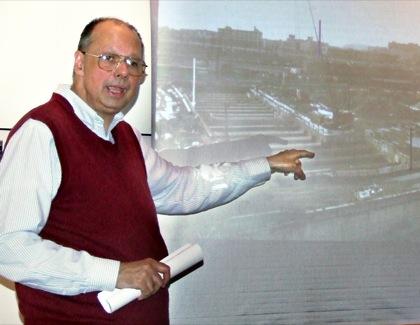BY Nathan Duke
Western Queens community activists said last week they hoped the city’s plan to preserve a European artifact believed to be the oldest in the borough was not set in stone.
The Greater Astoria Historical Society hosted a Nov. 18 discussion on how to preserve two large millstones that were constructed by the Dutch more than 450 years ago as part of a large tile mill in Long Island City.
The stones, believed to be the oldest surviving European artifact in Queens, are currently being held at a construction site within the massive Queens Plaza redevelopment project.
“Photos from even 20 years ago showed that they were in good shape,” said Bob Singleton of the historical society. “But there’s been substantial deterioration and their interiors have been filled with cement. The mill stones are not doing too well.”
Singleton said the stones, which are 4 to 5 feet in diameter and weigh at least 400 pounds, were used as part of the tile mill’s operation to grind wheat into flour. But the mill was closed down in the 1820s and its site was then owned by a family farm before Queens Plaza was created in 1909.
The contractor in charge of the plaza’s redevelopment, which includes street repaving and the creation of a new common area, currently has plywood sheets covering one of the stones, which is still embedded in the ground and slightly cracked, and is storing the other stone in a truck at the construction site.
“We’ve made sure the stones are not leaving the Dutch Kills area and that they are protected,” said George Stamatiades, president of the Dutch Kills Civic Association. “They are as secure as they can be and insured. And it’s been determined that they will not be moved until they are ready to be taken to their final setting.”
An artist associated with Astoria’s Socrates Sculpture Park will design a setting for the stones, which will be removed to a location that has yet to be determined, and an archeologist will study them once they are ready to be relocated, Stamatiades said.
But Queens community activists said they wanted the historical society to be allowed to take over the preservation of the stones.
“I believe the stones need to be studied in a place where they will not be subject to rain, snow or salt,” said Alfred Ronzoni, a member of the society. “They should eventually be housed in a museum.”
Christina Wilkinson, president of the Newtown Historical Society, said she did not support the city’s plan to hold the stones at the construction site until they are ready to be moved.
“They have sustained considerable damage under the city’s care,” she said. “The stones have significance beyond the value of dollars. They deserve to be treated with respect and restored.”
Reach reporter Nathan Duke by e-mail at nduke@cnglocal.com or by phone at 718-229-0300, Ext. 156.

































